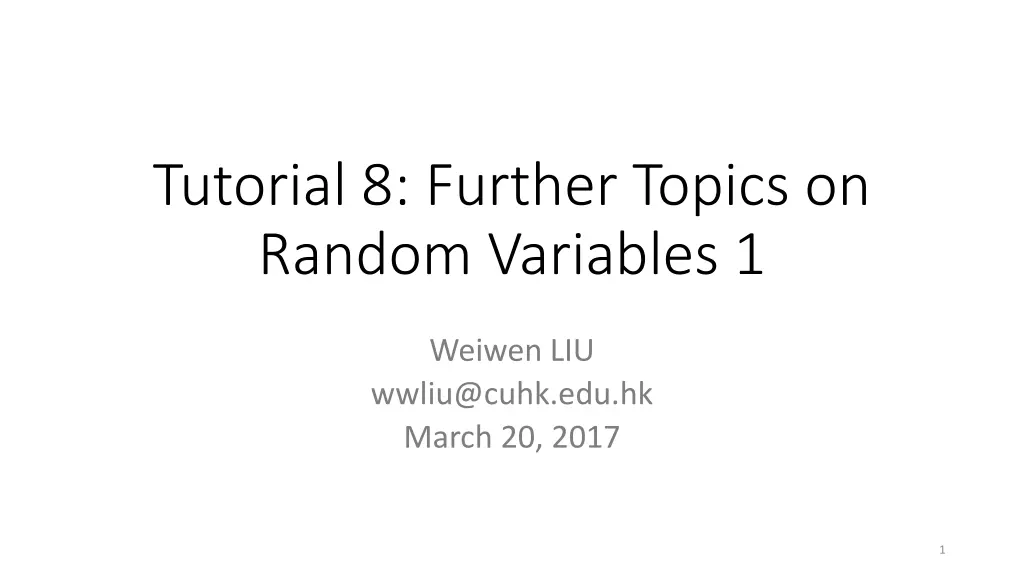
Random Variables - Derived Distributions and PDF Calculations
Learn how to calculate the PDF of a random variable using derived distributions, step-by-step approaches, and examples. Understand linear and monotonic cases for PDF calculations. Explore scenarios like archer shooting to apply the concepts practically.
Download Presentation

Please find below an Image/Link to download the presentation.
The content on the website is provided AS IS for your information and personal use only. It may not be sold, licensed, or shared on other websites without obtaining consent from the author. If you encounter any issues during the download, it is possible that the publisher has removed the file from their server.
You are allowed to download the files provided on this website for personal or commercial use, subject to the condition that they are used lawfully. All files are the property of their respective owners.
The content on the website is provided AS IS for your information and personal use only. It may not be sold, licensed, or shared on other websites without obtaining consent from the author.
E N D
Presentation Transcript
Tutorial 8: Further Topics on Random Variables 1 Weiwen LIU wwliu@cuhk.edu.hk March 20, 2017 1
Derived distributions Given ? = ?(?) of a continuous random variable ? and PDF of ?, how to calculate the PDF of ?? Two step approach 2
Calculation of PDF of ? = ?(?) 1. Calculate the CDF ?? of ? using the formula ??? = ? ? ? ? = ??(?)?? {?|?(?) ?} 2. Differentiate ??to obtain the PDF ?? of ?: ??? =??? ? . ?? 3
Calculation of PDF of ? = ?(?) Linear case: The PDF of ? = ?? + ? in terms of the PDF ?. ??? =??? 1 ? ? ? ? = |?|?? ?? Monotonic Case: Suppose that ?is monotonic and that for some function and all ?in the range of ? we have ? = ? ? if and only if ? = (?). Assume that is differentiable. ? ??(?) ??? = ?? (?) 4
Example 1 Let X be a random variable with PDF ??. Find the PDF of the random variable ? = |?|, 1 3,?? 2 < ? 1, 0, ?? ??????; (a) when ??? = (b) when ??? = 2? 2?,?? ? > 0, 0, ?? ??????; (c) for general ??(?). 5
Example 1 Since ? = ? , you can visualize the PDF for any given ? as ??(?) = ??? + ?? ? , 0, Also note that since ? = |?|, ? 0. ?? ? 0 ?? ? < 0 6
Example 1 1 3,?? 2 < ? 1, 0, ?? ??????; (a) Since ??? = So, ??(?) for 1 ? 0 gets added to ??(?) for 0 ? 1: 2 3,?? 0 ? < 1, 1 3,?? 1 ? < 2, 0, ?? ??????; ??? = 7
Example 1 (b) Here we are told ? > 0. So there are no negative values of ? that need to be considered. Thus f?y = ??? = 2? 2?,?? ? > 0, 0, ?? ??????. (c) As explained in the beginning, ??(?) = ??(?) + ??( ?). 8
Example 2: archer shooting Two archers shoot at a target. The distance of each shot from the center of the target is uniformly distributed from 0 to 1, independent of the other shot. Question: What is the PDF of the distance of the winning shot from the center? 9
Example 2: archer shooting Let ? and ? be the distances from the center of the first and second shots, respectively. ?: the distance of the winning shot: ? = min ?,? . Since ? and ? are uniformly distributed over 0,1 , we have, for all ? 0,1 , ? ? ? = ? ? ? = 1 ?. 10
Example 2: archer shooting Thus, using the independence of ? and ?, we have for all ? 0,1 , ??? = 1 ? min{?,?} ? = 1 ? ? ? ? ? ? = 1 1 ?2. Differentiating, we obtain ??? = 2(1 ?), 0, if 0 ? 1. otherwise. 11
Covariance The covariance of two random variables ? and ? are defined as cov ?,? = E E ? E E ? ? ? ? . Alternatively cov ?,? = E E ?? E E ? E E ? . 12
Correlation Coefficient For any random variable ?, ? with nonzero variances, the correlation coefficient ? ?,? of them is defined as cov(?,?) ?(?,?) = . var ? var(?) It may be viewed as a normalized version of the covariance cov(?,?). Recall cov ?,? = var ? . It s easily verified that 1 ?(?,?) 1 13
Example 3 A restaurant serves three fixed-price dinners costing $12, $15, and $20. For a randomly selected couple dinning at this restaurant, let ? = ? ? ???? ?? ? ? ??? ? ?????? and ? = ? ? ???? ?? ? ? ????? ? ??????. If the joint PMF of ? and ? is assumed to be, what is cov ?,? ? 14
Example 3 Cov ?,? = ?[??] ? ? ?[?] = 276.7 15.9 17.45 = 0.755 15
